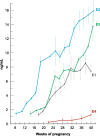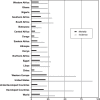Progesterone from ovulatory menstrual cycles is an important cause of breast cancer
- PMID: 37254150
- PMCID: PMC10228093
- DOI: 10.1186/s13058-023-01661-0
Progesterone from ovulatory menstrual cycles is an important cause of breast cancer
Abstract
Many factors, including reproductive hormones, have been linked to a woman's risk of developing breast cancer (BC). We reviewed the literature regarding the relationship between ovulatory menstrual cycles (MCs) and BC risk. Physiological variations in the frequency of MCs and interference with MCs through genetic variations, pathological conditions and or pharmaceutical interventions revealed a strong link between BC risk and the lifetime number of MCs. A substantial reduction in BC risk is observed in situations without MCs. In genetic or transgender situations with normal female breasts and estrogens, but no progesterone (P4), the incidence of BC is very low, suggesting an essential role of P4. During the MC, P4 has a strong proliferative effect on normal breast epithelium, whereas estradiol (E2) has only a minimal effect. The origin of BC has been strongly linked to proliferation associated DNA replication errors, and the repeated stimulation of the breast epithelium by P4 with each MC is likely to impact the epithelial mutational burden. Long-lived cells, such as stem cells, present in the breast epithelium, can carry mutations forward for an extended period of time, and studies show that breast tumors tend to take decades to develop before detection. We therefore postulate that P4 is an important factor in a woman's lifetime risk of developing BC, and that breast tumors arising during hormonal contraception or after menopause, with or without menopausal hormone therapy, are the consequence of the outgrowth of pre-existing neoplastic lesions, eventually stimulated by estrogens and some progestins.
Keywords: Breast cancer; DNA replication; Estrogens; Menstrual cycles; Progesterone; Tumor doubling time; WNT4.
© 2023. The Author(s).
Conflict of interest statement
HJTCB is President, IJS is Director R&D and JK is Chief Medical Officer of Pantarhei Oncology (subsidiary of Pantarhei Bioscience), the company developing the fetal estrogen estetrol for the treatment of advanced breast and prostate cancer, but this is outside the scope of the present review. The other authors have nothing to disclose.
Figures





Similar articles
-
Effect of levonorgestrel-releasing intrauterine device on hormonal profile and menstrual pattern after long-term use.Contraception. 1995 Jun;51(6):359-65. doi: 10.1016/0010-7824(95)00102-g. Contraception. 1995. PMID: 7554977 Clinical Trial.
-
Atypical estradiol secretion and ovulation patterns caused by luteal out-of-phase (LOOP) events underlying irregular ovulatory menstrual cycles in the menopausal transition.Menopause. 2009 Jan-Feb;16(1):50-9. doi: 10.1097/GME.0b013e31817ee0c2. Menopause. 2009. PMID: 18978637
-
Breast Cancer and Major Deviations of Genetic and Gender-related Structures and Function.J Clin Endocrinol Metab. 2020 Sep 1;105(9):dgaa404. doi: 10.1210/clinem/dgaa404. J Clin Endocrinol Metab. 2020. PMID: 32594127 Review.
-
Vitamin D and Reproductive Hormones Across the Menstrual Cycle.Hum Reprod. 2020 Feb 29;35(2):413-423. doi: 10.1093/humrep/dez283. Hum Reprod. 2020. PMID: 32068843 Free PMC article.
-
Review of menopausal hormone therapy with estradiol and progesterone versus other estrogens and progestins.Gynecol Endocrinol. 2022 Nov;38(11):891-910. doi: 10.1080/09513590.2022.2118254. Epub 2022 Sep 8. Gynecol Endocrinol. 2022. PMID: 36075250 Review.
Cited by
-
Reply: Premature ovarian insufficiency and the risk of breast cancer.Hum Reprod Open. 2025 Apr 9;2025(2):hoaf018. doi: 10.1093/hropen/hoaf018. eCollection 2025. Hum Reprod Open. 2025. PMID: 40226595 Free PMC article. No abstract available.
-
Innovative approaches in breast cancer therapy: repurposing nanocarriers for enhanced outcomes.Naunyn Schmiedebergs Arch Pharmacol. 2025 Apr 1. doi: 10.1007/s00210-025-04012-2. Online ahead of print. Naunyn Schmiedebergs Arch Pharmacol. 2025. PMID: 40167629 Review.
-
Risk factors for breast cancer subtypes by race and ethnicity: a scoping review.J Natl Cancer Inst. 2024 Dec 1;116(12):1992-2002. doi: 10.1093/jnci/djae172. J Natl Cancer Inst. 2024. PMID: 39018167 Free PMC article.
-
Breastfeeding's protective role in alleviating breast cancer burden: a comprehensive review.Ann Med Surg (Lond). 2024 Mar 5;86(5):2805-2811. doi: 10.1097/MS9.0000000000001914. eCollection 2024 May. Ann Med Surg (Lond). 2024. PMID: 38694322 Free PMC article. Review.
-
Transcriptomic Profile of Breast Tissue of Premenopausal Women Following Treatment with Progesterone Receptor Modulator: Secondary Outcomes of a Randomized Controlled Trial.Int J Mol Sci. 2024 Jul 10;25(14):7590. doi: 10.3390/ijms25147590. Int J Mol Sci. 2024. PMID: 39062832 Free PMC article. Clinical Trial.
References
-
- NBCC Breast Cancer Facts & Figures. https://www.stopbreastcancer.org/information-center/facts-figures/ (accessed on April 11, 2022).
-
- Cancer Research UK. Breast cancer statistics. https://www.cancerresearchuk.org/health-professional/cancer-statistics/s... (accessed April 11, 2022).
-
- ACS. Key statistics for breast cancer in men. https://www.cancer.org/cancer/breast-cancer-in-men/about/key-statistics.... (accessed on April 11, 2022).
Publication types
MeSH terms
Substances
LinkOut - more resources
Full Text Sources
Other Literature Sources
Medical

